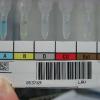Leaderboard
-
in all areas
- All areas
- Records
- Record Comments
- Record Reviews
- Jobs
- Jobs Comments
- Jobs Reviews
- Questions
- Question Comments
- Question Reviews
- Links
- Links Comments
- Files
- File Comments
- File Reviews
- Images
- Image Comments
- Albums
- Album Comments
- Records
- Record Comments
- Events
- Event Comments
- Blog Entries
- Blog Comments
- Topics
- Posts
- Status Updates
- Status Replies
-
Custom Date
-
All time
June 28 2007 - April 19 2024
-
Year
April 19 2023 - April 19 2024
-
Month
March 19 2024 - April 19 2024
-
Week
April 12 2024 - April 19 2024
-
Today
April 19 2024
-
Custom Date
03/22/2017 - 03/22/2017
-
All time
Popular Content
Showing content with the highest reputation on 03/22/2017 in all areas
-

Warm free auto antibody with weak auto control
David Saikin and 2 others reacted to Malcolm Needs for a topic
I am afraid that I am not totally convinced that what you have here is a "warm" auto-antibody. I just wonder if, what you have is either a "cold" auto-antibody of wide thermal amplitude or, possibly, but seen less commonly, a case of a mixed "warm" and "cold" auto-antibody, however, having said that, I am not certain, from what you have written, whether or not the direct tube testing at room temperature was performed on allo-adsorbed plasma or "neat" unadsorbed plasma. Please would you clarify this? Please would you also try to tell us the patient's underlying pathology? I would not worry too much about the patient's autologous red cells give slightly weaker reactions than those seen with panel cells or screening cells. The autologous red cells will have been "bathed" in the high titre antibody in vivo, whereas the other red cells are, if you like, "meeting the antibody for the first time"! It is likely, therefore, that there is a certain amount of "antigen blocking" going on with the autologous red cells.3 points -

Antibody Screen before Issuing RhIg
seraph44 and one other reacted to mollyredone for a topic
I agree with Dansket. There is too much insurance card swapping and sharing going around to rely on a historical type, even if andministration of Rhogam would not necessarily be that harmful. We require a current type for everything except emergency release/massive transfusion and even then we would like to a specimen sooner than later so we're not pouring out ON for child-bearing females.2 points -
Interesting topic. In just a few posts, it is easy to see there is a variety of ways labs approach the "how often are elutions performed" question and under what circumstances. I too agree with Malcolm; in the presence of AIHA and a positive DAT, most likely you will get off a panagglutinin every time you perform an elution. Once this occurs, there is no point in performing additional elutions on a routine basis. In the patient though who has a positive DAT and is transfused on a regular basis, and has a negative eluate (yes, this does occur) the elution question is a bit different. Technically, any transfusion can result in the production of an alloantibody that may or may not present itself in a hemolytic fashion. It is possible to have a "delayed serologic transfusion reaction" that shows no signs or symptoms of a hemolytic process. In this scenario, the idea of not doing an elution on a regular basis because it has never revealed anything in the past, may result in missing a newly formed, clinically significant antibody that is only detectable in the eluate. Not performing an eluate in this scenario is not without risk and should not ever become "policy" without proper overview of the clinical situation.2 points
-

ABO/Rh confirmation labels--necessary??
Likewine99 reacted to Cliff for a topic
I know this post is almost 4 years old, but it was quoted a couple of hours ago and I find the highlighted part interesting. Not sure how big of a facility you are, or how much you transfuse. We're decent size, we transfuse about 24 - 28k RBCs a year. I've been at my current location for 26 years. That's approaching three quarters of a million red cells we've retyped in my time there. I recall only one unit we received from a facility that was mislabeled. That's pretty good evidence that retyping, while required, does not add a lot of value. The odds that something would go wrong are beyond astronomical. You'd have to have a mislabeled unit, you'd be on downtime, it would mistakenly get into the retyped area, then it would have to go to a patient where it could cause harm, then the odds that it actually would cause harm are still small.1 point -

Antibody Screen before Issuing RhIg
mollyredone reacted to Dansket for a topic
We don't perform an antibody screen for either the Antepartum RhoGAM protocol or the Postpartum RhoGAM protocol. We don't issue RhoGAM without an Rh type done on a current blood sample for either protocol.1 point -

Automated Cord Blood Testing
tbostock reacted to Laurie Underwood for a topic
We run cord blood samples collected in a purple top EDTA on the TANGO. Check for and remove any clots with applicator sticks and centrifuge for 5 minutes before testing. Has been working fine.1 point -
An interesting twist ! One could look at it that way. Red cell products ultimately do deteriorate and that's why they must have an expiration date. Hemolysis is often the first visual clue. However, that doesn't mean that all of the antigens have suddenly become unrecognizable; it just means some of the older cells in the vial have popped. Studies have been published demonstrating that antigens remain stable many days/weeks after official expiration. Manufacturers do have oodles of stability data - both static (in-house) and following shipping. Typically a unit of red cells that is turned into a red cell product has at least an eight-week expiration. This allows for manufacturing and shipping to the end users who then usually have five-weeks left on the expiration. In reality, those expiration dates could be longer, but the manufacturers deliberately give themselves a buffer period, just in case. The wildcard in this whole process and issue upon which the regulatory agencies focus is shipping. How do the end users know that something horrible didn't happen to the material ? An unanswerable question. Even though the manufacturers have shipping stability data, they can't possibly foresee and test every odd, weird situation. One could argue that Ortho have less faith in their shipping process than other suppliers, hence the requirement for periodic QC.1 point
-
Ortho Panel Cells -Quality Assurance
John C. Staley reacted to Ensis01 for a topic
I'm not trying to be funny; but if Ortho requires the lab to QC the panel periodically why do the panels have an expiry date. I mean it has been pointed out in several threads that the manufacturers QC and stability testing and requirements must far exceed what a lab could do or be expected to do. Am I missing something?1 point -

Ortho Panel Cells -Quality Assurance
lehooke1 reacted to Joanne P. Scannell for a topic
We do both of the above ... 1. Test the panel against QC antisera upon receipt, as we do for all reagents; It shows the reagent survived shipment. 2. Record the Lot#/Cell# and antigen types (zygocity) of the cells used for Antigen Typing QC (heterozygous except K) ... that's periodic enough.1 point -

Ortho Panel Cells -Quality Assurance
Joanne P. Scannell reacted to Malcolm Needs for a topic
Completely agree. We have something called "the element of uncertainty" (it isn't "element", but it is something similar) that is required by one of our more officious regulators (not that any of them are less than officious), but we struggle with this because, apart from titrations/quantifications and measuring an FMH, I struggle to think of any tests that we perform that are quantitative, rather than qualitative, which means there is no "element of uncertainty" - as long as your controls have worked, but these numpties stil ask for evidence. You will be surprised to learn that most of the inspectors for this particular regulator have never stepped foot over the threshold of a transfusion laboratory prior to inspection!!!!!!!!!!!!!!!1 point -

Ortho Panel Cells -Quality Assurance
lehooke1 reacted to John C. Staley for a topic
This topic keeps popping up periodically and I find it both interesting and frustrating. My personal view, as stated in previous discussions on the topic, is that what ever you do is little more than smoke and mirrors in an attempt to pacify some regulator. I'm sure that's also why the manufacturer puts such nonsense in their package inserts. They claim specificity for many antigens yet it is acceptable to confirm the reactivity of a select few!! I'm sure that can be rationalized but it still makes no sense to me.1 point -
I am still astounded that this is still necessary. All UK units are guaranteed so this is not needed. How can you have any faith in your reference centres if you can't trust them to get an ABO correct?1 point
-

ABO/Rh confirmation labels--necessary??
BBfuntimes reacted to jayinsat for a topic
Not to be argumentative but we blood bankers tend to be overly paranoid. What is the percentage of units you recieve from your supplier that are incorrectly labeled aborh? How often does units get mistakenly placed on the confirmed shelf, picked up by a tech, crossmatched and released for transfusion, all before your LIS is back up? I think if you really look at the odds of a negative outcome situation that would be averted by the use of a sticker, you'd see that your fears are really unwarranted. Risk is never truly mitigated completely.1 point -

ABO/Rh confirmation labels--necessary??
tricore reacted to Likewine99 for a topic
Same as David, quit using them about 20 yrs ago. They do not add any value to the retype process and they usually ended up falling off and sticking on the refrig, us, the floor, etc. This of the money you will save not buying labels and with the time saved you might have time to get to lunch/dinner on your shift1 point -

ABO/Rh confirmation labels--necessary??
tricore reacted to David Saikin for a topic
We haven't used them in decades . . . even now when we no longer have a BBIS they are not necessary. Even before BBISs we never used them.1 point -

ABO/Rh confirmation labels--necessary??
tricore reacted to Dr. Pepper for a topic
Our past and present lab computer systems (Sunquest and Meditech) won't let you allocate a unit if the retype has not been done. We do the retypes as soon as we enter them into inventory. As with the others above, we haven't used retype stickers for years.1 point -
ABO/Rh confirmation labels--necessary??
John C. Staley reacted to Townsend for a topic
If you are retyping in the computer, the labels shouldn't be required as long as you have a way to distinguish between units which are available for crossmatching and those that still need retyping. We do this by placing all unconfirmed units on a designated shelf until the are retyped. Stephanie Townsend, MT(ASCP)SBB1 point -
Haven't used them for 20+ years.1 point
-

ABO/Rh confirmation labels--necessary??
lehooke1 reacted to JOANBALONE for a topic
Dump the labels. This is the 21st century.1 point -

Cooler validation/ QC
Moira Johnson reacted to Cliff for a topic
I don't know if I agree with these statements. We use Igloo coolers with a corrugated plastic insert (custom made). We have about 50 coolers and replace them on a regular basis. They are used a lot. When we validate them, they don't all pass. Some maintain temp better than others. So if we were to validate just the method, then it might mislead us in thinking they were all good (or all bad). As for twice a year, what are you proving by doing that? That the one that you validated still works and represents all of them? What if one has a crack in it but you didn't pick that one for the validation. Is it still good? I wish there were some good guidance on issues like these. We all want to do the right thing, but we all also fear hearing an inspector say that what we did is not enough, and their unfounded advice is to do more.1 point -

childbearing age
carolyn swickard reacted to Mabel Adams for a topic
We will be going live with Meditech in the next few weeks. It took some building but we got it so it will warn when we crossmatch or issue Rh pos to a neg pt. Our old system, Hemocare, did this automatically. We aren't required to enter a reason. Hmm. Wonder if I could make it do that?1 point
